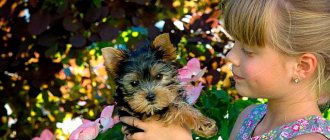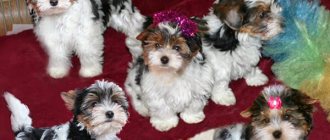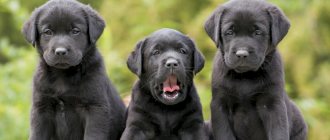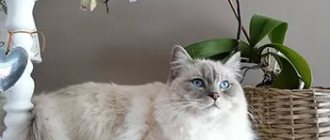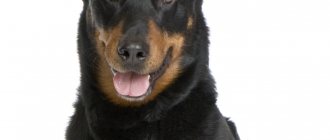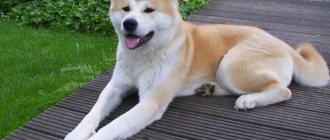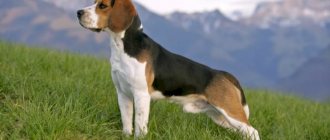- Pets
- >>
- Cat breeds
* Here is a photo of a typical representative of the Scottish Fold cat breed . You can send us photos of your animals by email, and we will post them on the website. Don't forget to send your pet's name.
Other breed names:
Scottish fold
Video
* We invite you to watch a video about the Scottish Fold cat . In fact, in front of you is a playlist in which you can select and watch any of 20 videos about a given cat breed by simply clicking on the button in the upper right corner of the window. In addition, the material contains quite a lot of photos. By looking at them you can find out what a Scottish Fold cat looks like.
In this article:
|
History of the origin of Scottish Fold cats
The Scottish Fold breed appeared relatively recently, about 50 years ago. The ancestors and main relatives of Scottish Fold cats are British Shorthair cats. Despite the fact that the ancestors of animals of this breed were short-haired, the first kittens of this breed had mostly long hair. The first kitten known to the world was bought by Valery Ross in 1961 on a farm in the Scottish city of Tayside.
The kitten was unique in its own way; it had unusual ears that hung forward. The kitten's mother, the cat Susie, was the very first representative of this breed and gave such beautiful offspring. In 1973, kittens of this breed went to the famous cat breeder Sally Wolfe Peters, and this breed attracted public attention.
In 1978, cats of the Scottish breed participated in cat shows and received the status of the Cat Fanciers' Association. More and more people wanted to get such cute pets, however, for a long time they did not dare to breed cats of this breed in nurseries, and even a ban was introduced on the breeding of cats of this breed. This prohibition is due to the fact that if you cross a cat and a cat of the fold breed, offspring will be born with disorders in the musculoskeletal system.
Such animals cannot live a full life. The breed can only exist by crossing lop-eared individuals with individuals with straight ears. When these recommendations are followed, healthy fold-eared offspring are born. In 1993, the CFA adopted a standard corresponding to this breed.
Price
The cost of a kitten depends on a number of factors - primarily pedigree, necessary documents, hereditary diseases and habits. There are several classes of pedigree kittens.
- Show class is the elite of this breed. Parents participated in exhibitions and received awards. The cost of such a copy is from 1200 to 2500 euros.
- Breeds are proven healthy babies with a decent pedigree and documents. Allowed for exhibitions. The price ranges from 500 to 1000 euros.
- Pets are purebred pets that were disqualified from participation in exhibitions for minor reasons and are not allowed to breed. This is the best choice if you just want to have a furry pet at home and don’t need a show piece. The average price for a Scottish Fold in this category in nurseries ranges from 100 to 500 euros.
It is advisable to choose well-known nurseries and trusted breeders. Do not try to buy on sales sites, although the cost there may be lower. You must receive a guarantee of purebredness and health. Even if it's a little more expensive. There are nurseries in Russia that breed these cats. For example, in Moscow Ermine Trace.
Scottish Fold cat - description of the breed
Scottish cats come in several types:
- Scottish Straight (short-haired fold);
- Helend-fold (long-haired fold);
- Hayland Straight (long-haired straight).
Fold cats have a powerful body with developed and strong muscles. The animal's height is 24-25 cm and its weight is about 4.5 kg. The head is round, large round eyes are set wide apart. The iris of the eyes is most often amber-yellow, but can also match the color of the cat. The animal's face has particularly pronounced chubby cheeks and a well-developed chin. The whisker pads are round. The neck is powerful. The cat's paws are short but powerful. The chest is large and voluminous. Shoulders and hips are the same size and shape.
A special feature of cats of this breed are neat small triangular ears curved forward. Due to the unusual crease of the cartilage, the ears are pressed tightly to the head, and the tips of the ears are directed forward and downward. By the way, small kittens of this breed are born with straight ears, but by the end of the first month of life, the kittens’ ears begin to “sag,” and over time they bend, almost completely pressing against the skull.
The Scots have a long tail, slightly tapered at the end. Animals with a movable tail are especially valued due to the fact that this breed often has mutations that lead to diseases of the musculoskeletal system; when purchasing, they always look at the mobility of the tail. The fluffiness of the tail also affects it; previously, a fluffy and beautiful tail was considered a cat’s real asset, until it turned out that such a fluffy tail interferes with the animal’s movement.
Now the fluffy tail of a fold-eared cat is a reason for disqualification from a cat show. The animal's fur is soft, plush with a rather thick undercoat. The color of the animal may vary. The average lifespan of Scottish Fold cats is 10-15 years, however, there are individuals that live up to 20 years.
Popular colors of Scottish Fold cats
The color of Scottish cats can vary.
The most common types of colors are:
- Solid solid colors;
- Bicolors;
- Tortoiseshell colors;
- Tabby color;
- Calico color;
- Chinchilla color;
- Harlequin color;
- Color van;
- Shaded color;
- Tacked color.
Solid color means the absence of any inclusions of another color. If there are hairs of a different color, this is either a color defect or a color of a different type. Solid colors are: blue, ebony, chocolate, fawn, lilac, cream, red.
Bicolor is a color that contains white in addition to the main color. In this case, the upper half of the animal is often painted in one color, and the abdomen, lower part of the muzzle and the tips of the paws are white. Ideally, the designs should be symmetrical.
Point. A color in which there is a basic light tone throughout the body, and a darker coat color on the face, paws and tail. Point-colored cats have a gene that causes the fur to darken in those parts of the body where the body temperature is lower due to poor blood circulation.
The tortoiseshell color is distinguished by the presence of dark spots and spots of red color. It should be noted that tortoiseshell colors are found only in cats; if such a color is seen in a cat, this indicates a genetic mutation in which the animal cannot bear offspring.
Tabby color. Cats with brindle, spotted or marbled color.
Shaded color - colors in which the main part of the hair is white, and only the upper part of the hairs is colored a different color.
Wang. Van cats are white, but the tail and face are a different color.
Harlequin. The Harlequin color is characterized by the fact that against a general white background there are spots of other colors.
Breeders value Scottish fold cats of tortoiseshell color, since such a cat is a carrier of the genes of the black and red series. Although all the colors of the Scots are especially beautiful.
Character and habits of Scottish Fold cats
Scottish Folds are simply created for life in a large family. They are very sociable and playful. They love to involve all family members in their games. Scottish cats are very sociable and get along well with children and the elderly. They allow children to cuddle themselves and play with them with pleasure. As for the character of each individual, like people, it is individual; some associate the color of an animal with certain character traits.
For example, it is believed that blue Scots, due to their British genes, have a more quarrelsome character, and on the contrary, bicolors are considered cats with a soft and good-natured character. However, each animal is individual in one way or another. Some Scots do not leave the hands of the owner and strive to be close to the owner, while others, on the contrary, do not let anyone near them.
Interesting fact: Handsome adult lop-eared cats can easily tolerate loneliness and can sleep all day or occupy themselves on their own. However, if the animal wants attention or gets hungry, it will definitely let you know about it with its loud “meow”.
The Scots also have such character traits as stubbornness and willfulness. Often expressed in whims and a desire to be the center of attention. Although these cats can be trained well. At the genetic level, cats of this breed have certain beautiful manners. The Scots are well accustomed to the litter box, they recognize the scratching post and do not damage the furniture; they behave quite decently and decently.
Even if the cat is offended by something, he will not take revenge. The Scots never steal food, they can eat from the table or from the pots, but they never hide, but eat calmly and openly, with the dignity of kings.
Attitude towards children
Scottish Folds are an amazing breed, because aggression is completely uncharacteristic for them. They make excellent playmates for children. You can safely leave your child next to your pet and be sure that he will not bite or scratch you. In the case of an unceremonious attitude, the Scottish Fold will simply withdraw from communication, run away or hide.
For playing with children, it is recommended to take grown-up Scottish Fold kittens into the family. At this age they are highly trainable. The kids will be interested in learning a few tricks with their pet, and then demonstrating their success in front of other family members.
Interesting facts about Scottish Fold cats
The first fold-eared cats appeared completely by accident due to a genetic mutation; later people fixed this gene artificially. Fold-eared cats cannot have healthy offspring within their breed; when crossing a fold-eared cat with a fold-eared cat, kittens with diseases of the musculoskeletal system are born, therefore, to obtain healthy offspring, fold-eared cats are crossed with straight-eared cats.
Scottish cats can come in a variety of colors. For a long time, there was a ban on breeding cats of this breed all over the world, but after breeders learned how to correctly cross fold-eared cats with straight-eared cats, it became allowed to breed cats of these breeds in nurseries. One litter usually produces 4 kittens.
It has been noticed that Scottish cats love to stand on their hind legs and stand in the gopher pose for a long time. Scottish Fold cats do not like heights, so with a cat of this breed you don’t have to worry about chandeliers and high shelves. The cat definitely won't go there.
Scottish cats are very smiling - this facial expression is obtained due to the rounded convex cheeks and the round shape of the head. The Scottish Fold cat has an unusual, peculiar, hoarse voice. Small fold-eared kittens are born with straight ears, and only by the time the kittens are a month old do the ears begin to sag a little.
By the age of four months, kittens have a dense undercoat, their ears become tightly pressed to their heads, that is, the kittens become similar to their parents. Remember the Soviet cartoon “Kid and Carlson”? The famous and lazy cat Matilda is the first representative of the Scottish Fold breed to appear on Russian screens.
Pros and cons of Scottish Fold cats
The main advantages of these cute cats include the following qualities:
- Kindness. It’s difficult to piss off a Scot, but it’s still possible;
- Good attitude towards children;
- Sociability and cheerful disposition;
- Dignified, almost aristocratic behavior;
- Lack of touchiness. Even if you offend the cat, he will not do anything dirty in revenge;
- Mind. Scottish Fold cats are quite smart cats, they quickly get used to the tray and scratching post, and respond well to the calm words of the owner. If a Scottish Fold cat does not obey its owner, it means that the cat most likely does not like the way he is being treated;
- They get along calmly with other pets and do not share territory even when they are close to cats. He can even be friends with a dog if he treats the cat well;
- Despite their good disposition, Scottish cats are still predators, and they are excellent at catching mice and sometimes birds.
There are disadvantages to cats of this breed and they cannot be ignored:
- Cats of this breed must be brushed at least a couple of times a week in order to remove dead hair and massage the animal’s skin;
- Scottish Fold cats are simply extremely inquisitive. They love to watch what the owner is doing and climb into all secluded places;
- Sometimes there is excessive affection, but it all depends on the individual characteristics of the animal. Plus, Scottish Folds don’t particularly like guests and treat new people in the house with caution, although they behave quite decently;
- Scottish cats often love to lick themselves, and during licking, hair gets into the animal's body, so cats of this breed must be fed with special food to remove hair from the stomach.
Playfulness
The Scottish Fold cannot be called a hyperactive breed, although young kittens are very playful. By nature they are excellent hunters. Hunting is the main activity for animals living in the wild. Games that simulate a chase help the Scottish Fold to maintain physical fitness and spur the instinct of a wild animal.
Movement and play are essential components of the physical and emotional health of the Scottish Fold. In addition, the game for a kitten is a method of studying the world around us and those who live in it.
Breeding Scottish Fold cats
Breeding Scottish cats is a very complex process since these cats have problematic genes, the manifestation of the negative consequences of these genes can only be avoided by selecting a pair. By the way, it’s exactly the same story with Munchkin cats. Fold-eared cats are never bred with a fold-eared partner, since in this case offspring are born with serious genetic diseases of the musculoskeletal system. Cats of the Scottish Fold and Highland Fold breeds are crossed exclusively with the straight-eared Scottish Straight and Highland Straight, only with such mating the offspring are born healthy.
Cats are ready for mating at the age of one and a half years. You cannot breed cats during their first heat; you must wait until the second, or better yet, the third. It is also worth remembering that a cat can become pregnant on the second or third day of estrus. The first mating process is quite complicated, and nature does not always tell cats what to do. If the cat has not interacted with her own kind before, the process of the first mating can be very complicated. In this case, cats begin to show aggression towards their partner, hissing and growling menacingly.
Even if the cat behaves calmly, she can simply lie on her side and not let the cat near her. Mating of Scottish cats should always take place in the male's territory. In this case, the male feels completely safe and can spend all his energy courting the cat. The cat's owners are only required to correctly calculate the day when to produce it, and provide the cat with its usual food and litter tray for the mating period.
Mating usually takes 2-3 days. On the first day, the animals get to know each other, adapt and form sympathy. Mating occurs on 2-3 days. During the mating period, cat owners must allocate a separate room for the cats, where no one will disturb them, and the area must be closed so that the guest cannot escape. Cat mating games go something like this: the male settles down at a short distance from the cat and does not show any attention, sometimes he comes closer to the female, but she scares him off with a menacing hiss.
Later, the cat pretends to be asleep and doesn’t care about the female at all. Discouraged by the lack of attention, the cat begins to roll on the floor and meow, calling for a male. When the cat begins to show interest, the cat becomes aggressive again. This is repeated over and over again until the cat gets bored and stops resisting. Sexual intercourse in cats lasts about 5-10 seconds. About 10-16 matings occur within a few days.
The main signs of pregnancy in a cat:
- Morning sickness;
- The cat's nipples become swollen;
- The cat's appetite increases greatly;
- Character changes;
- The animal becomes more nervous;
- The cat may be aggressive;
- At the end of the second week of pregnancy, the fetuses can be felt by palpation;
- A cat's pregnant belly appears towards the end of the 6th week of pregnancy.
Pregnancy in Scottish cats lasts approximately 9 weeks. One litter usually produces 4 kittens.
Maintenance cost
Privileged socialization and a comfortable life for the Scottish Fold in the house begin with the preliminary organization of the house and the acquisition of a basic set of cat accessories:
- Bed or house – 2000-3000 rubles.
- Tray - about 1500 rubles.
- Filler (clay or wood is recommended for kittens) – 280 RUR
- Bowls for food and water – 1000 rubles.
- Scratching post – 294 rub.
- Harness and leash for walking – 483 RUR
- Carrying – 660 rub.
- Toys - about 500 rubles.
Total: 11172 rub.
Nutrition
If an industrial diet is chosen, your pet will need four kilograms of dry food per month.
A two-kilogram pack of Natural Greatness “Field&River Recipe” food costs 1,986 rubles.
1986x2= 3964 rub.
When feeding with natural food, you will need about 7 kg of meat or offal worth about 2000 rubles.
Additional products will cost about the same.
2000x2=4000 rub.
Veterinary
The Scottish Fold should be taken to the veterinarian every year to assess its health. In addition, the animal is vaccinated annually with a complex vaccine, dewormed and protected against fleas and ticks.
- Medical examination of a young Scottish Fold on average (external examination, general blood test, selection of diet, recommendations) – 5,000 rubles.
- Vaccination (panleukopenia, rhinotracheitis, calcevirosis, chlamydia) – 1500 rubles.
- Comprehensive protection against helminths, fleas, ticks, ear mites - stronghold drug (drops on the withers) - 450 rubles. (the drug is applied 2 times a year)
Total: 7400 rub.
If Scottish Fold disease occurs, costs will increase significantly.
- Simple operation - from 20,000 rubles.
- Hospital stay – 5500
Total: 36,500 rub. 3 days in hospital + surgery
Grooming
The coat of the Scottish Fold needs to be cared for regularly, so you will have to purchase a small kit in advance for high-quality combing and bathing procedures. In addition, you will need to care for your ears, eyes, teeth, and claws:
- Fuminator FURminator for short-haired cats – RUB 1,976.
- Glove for combing cats – 178 RUR.
- Nail clippers with bottom lock – 193 RUR.
- Hypoallergenic shampoo for cats Elite Organic – 599 RUR.
- “Otokeya” ear lotion, cleansing – 195 RUR.
- Cliny eye lotion – 259 RUR.
Total: 3400 rub.
Exhibitions
The total cost of participation in the Scottish Fold exhibition depends on the size of the entry fee, the class of the event, how many cats will participate in the event, the number of days of presence, and transportation costs. Approximately, the costs of participating in the exhibition will look like this.
- Exhibition fee – 2500 rubles.
- Certificate from a veterinarian – 600 rubles.
- Preparation of the animal - 3000 rubles.
- Exhibition tent – 5000 rub.
- Folding tray, filler, bed, diapers, water, food - 3000-4000 rubles.
- Participation in rings and shows – 500 rubles.
Total: 15,600 rub.
Caring for Scottish Fold cats
Folds are quite unpretentious by nature. But do not forget that they are very inquisitive, they love to climb into various secluded places, play with wires and cables that they can chew. They might get stuck somewhere or fall out of a window. Therefore, before bringing a kitten into the house, it is better to prepare a little.
Hide all wires and chargers, put valuables away. The animal should prepare a sleeping place, a place for food with several bowls and a tray with filler. Little kittens are very playful, so to prevent the kitten from getting bored, it is better to purchase special toys. Pay special attention to caring for your pet's coat.
Interesting fact: The Scotsman needs to be brushed once a week with a special soft comb. At the same time, you should not use a slicker because it can damage the delicate undercoat. If the cat does not go outside but lives in an apartment, bathing it once every six months is enough.
After bathing, the kitten should be wrapped in a soft towel, and then the fur should be dried thoroughly so that the kitten does not catch a cold. Once a month, trim the tips of the animal’s claws with special scissors; this must be done carefully so as not to cause pain to the cat. You should also clean your pet’s ears every few weeks. This is done with a cotton swab.
Scottish cats have an excellent appetite and are prone to obesity, so try to choose a balanced diet without overfeeding the animal. Kittens should be trained from the first days the animal appears in the house. The kitten must immediately be accustomed to the tray, scratching post, and sleeping place.
It is necessary to immediately stop negative actions, otherwise it will be almost impossible to wean the kitten later. Folds have an extraordinary mind and good manners from birth, so raising these cats is quite easy for the owners of these pets.
How to choose a kitten
Scottish babies acquire skills by about three months of age. Only at this time can they be taken from their mother. By this point, kittens are usually weaned off cat milk and care. True, at first the baby will have to be fed with milk formulas, to which he is accustomed.
When choosing a purebred Scottish kitten, first pay attention to its character, and only then to its external features. After all, overly modest, frightened kittens are unlikely to become brave, desperate pets. But if you devote a lot of time to raising them, then smart Scots will certainly surprise you. They will try to do everything to please their owner and make him happy.
The cost of Scottish breed kittens depends on the availability of accompanying documents. The price of such a pet without a veterinary passport usually ranges from 2-3 thousand rubles. But the presence of all the necessary documents often increases this cost tenfold.
Do you want to get a charming Scottish kitten? Surely this decision will be the right one, and your household will definitely greet the idea with delight. After all, cute straights and folds have such an affectionate, playful and flexible character that it is impossible not to fall in love with them. And if you remember the round, charming face with beautiful big eyes shining with curiosity, then you can’t imagine your future life without this pet.
Diet of Scottish Fold cats
A cat's diet should be varied and include all the necessary vitamins and microelements that the animal needs. For Scots, premium food is usually used, alternating dry food with canned food. Since hair constantly gets into the animal’s body when licking, it is better to give preference to foods that cleanse the cat’s stomach of hair.
In addition, it is good to feed the animal with natural products such as:
- Boiled lean meat (veal, beef, chicken, pork);
- By-products (liver, spleen, lungs, kidneys);
- Boiled fish of low-fat varieties;
- Quail eggs or chicken egg yolks;
- Cheese, fermented milk products (kefir, sour cream, yogurt, etc.);
- Boiled vegetables.
Under no circumstances should cats be given smoked meats and salted fish; cats’ livers cannot cope with such heavy food. Since pets of this breed are prone to obesity, it is better not to overfeed them. In addition to food, you should ensure that the animal always has clean water in its bowl. The remains of uneaten food should be removed and the bowls should be washed well so that the cat does not get poisoned by spoiled food.
For pregnant cats, portions should be increased; it is advisable to add special vitamin complexes and calcium to the food, which can be purchased at a veterinary pharmacy. Neutered Scots are more prone to obesity than cats of other breeds, so it is better to feed them with special light, balanced food for neutered cats.
Diseases and health problems
Due to the fact that this breed was created by nature due to a genetic mutation, Scottish Folds may suffer from genetic diseases such as osteochondropathy. This is a hereditary congenital disease that can be fatal to the animal.
These cats may also suffer from other congenital diseases such as arthritis, chondrodystrophy, arthrosis. These diseases are most often the cause of incorrect crossing of lop-eared and straight-eared pets. Therefore, when buying a kitten, you need to pay special attention to the kitten’s movements, gait, and tail movement.
Due to the unusual shape of the eyes, Scots often suffer from entropion, and the animal requires surgical intervention. Older cats may develop cataracts or glaucoma.
Important fact: Some cats may be allergic to certain types of food, so if you notice that your cat is itching and acting strange, it is best to take the animal to the vet.
Older cats may suffer from diseases of the cardiovascular system, stomach and liver problems may occur, so once a year the animal must be shown to a veterinarian. Through contact with other animals, a cat can also become infected with various parasitic diseases. Therefore, it is always necessary to take preventive measures and avoid contact with carriers of parasites.
Life expectancy - how long do Scottish Folds live?
With excellent care, the Scottish Fold can live a long, active life. The average duration is from 15 to 18 years. Since the Scottish Fold is an artificially bred breed, the influence of genes on health, and therefore on life expectancy, is quite large. Unfortunately, the Scottish Fold is characterized by a tendency to a number of genetic pathologies. The kitten receives these diseases of the breed from its parents and earlier ancestors. That's why choosing a future pet should begin with getting to know its father and mother.
A proper lifestyle for the health of the Scottish Fold is extremely important. The pet must exercise enough and eat properly. In addition, injuries and stress should be excluded. If any problems arise, it is important to immediately contact a veterinarian in order to diagnose pathologies at an early stage.
